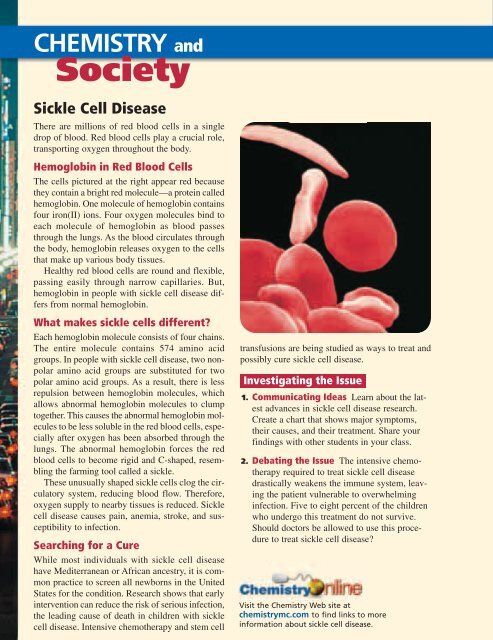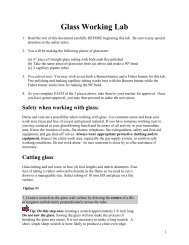Chapter 15: Solutions - Weironline.net
Chapter 15: Solutions - Weironline.net
Chapter 15: Solutions - Weironline.net
Create successful ePaper yourself
Turn your PDF publications into a flip-book with our unique Google optimized e-Paper software.
CHEMISTRY and<br />
Society<br />
Sickle Cell Disease<br />
There are millions of red blood cells in a single<br />
drop of blood. Red blood cells play a crucial role,<br />
transporting oxygen throughout the body.<br />
Hemoglobin in Red Blood Cells<br />
The cells pictured at the right appear red because<br />
they contain a bright red molecule—a protein called<br />
hemoglobin. One molecule of hemoglobin contains<br />
four iron(II) ions. Four oxygen molecules bind to<br />
each molecule of hemoglobin as blood passes<br />
through the lungs. As the blood circulates through<br />
the body, hemoglobin releases oxygen to the cells<br />
that make up various body tissues.<br />
Healthy red blood cells are round and flexible,<br />
passing easily through narrow capillaries. But,<br />
hemoglobin in people with sickle cell disease differs<br />
from normal hemoglobin.<br />
What makes sickle cells different?<br />
Each hemoglobin molecule consists of four chains.<br />
The entire molecule contains 574 amino acid<br />
groups. In people with sickle cell disease, two nonpolar<br />
amino acid groups are substituted for two<br />
polar amino acid groups. As a result, there is less<br />
repulsion between hemoglobin molecules, which<br />
allows abnormal hemoglobin molecules to clump<br />
together. This causes the abnormal hemoglobin molecules<br />
to be less soluble in the red blood cells, especially<br />
after oxygen has been absorbed through the<br />
lungs. The abnormal hemoglobin forces the red<br />
blood cells to become rigid and C-shaped, resembling<br />
the farming tool called a sickle.<br />
These unusually shaped sickle cells clog the circulatory<br />
system, reducing blood flow. Therefore,<br />
oxygen supply to nearby tissues is reduced. Sickle<br />
cell disease causes pain, anemia, stroke, and susceptibility<br />
to infection.<br />
Searching for a Cure<br />
While most individuals with sickle cell disease<br />
have Mediterranean or African ancestry, it is common<br />
practice to screen all newborns in the United<br />
States for the condition. Research shows that early<br />
intervention can reduce the risk of serious infection,<br />
the leading cause of death in children with sickle<br />
cell disease. Intensive chemotherapy and stem cell<br />
482 <strong>Chapter</strong> <strong>15</strong> <strong>Solutions</strong><br />
transfusions are being studied as ways to treat and<br />
possibly cure sickle cell disease.<br />
Investigating the Issue<br />
1. Communicating Ideas Learn about the latest<br />
advances in sickle cell disease research.<br />
Create a chart that shows major symptoms,<br />
their causes, and their treatment. Share your<br />
findings with other students in your class.<br />
2. Debating the Issue The intensive chemotherapy<br />
required to treat sickle cell disease<br />
drastically weakens the immune system, leaving<br />
the patient vulnerable to overwhelming<br />
infection. Five to eight percent of the children<br />
who undergo this treatment do not survive.<br />
Should doctors be allowed to use this procedure<br />
to treat sickle cell disease?<br />
Visit the Chemistry Web site at<br />
chemistrymc.com to find links to more<br />
information about sickle cell disease.




